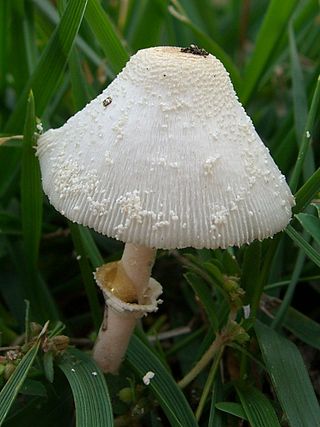
Leucocoprinus cepistipes, is a species of fungus in the family Agaricaceae. It is also known by the common name onion-stalk parasol in reference to the bulbous stem base. It is typically found on wood debris, such as wood chips but may also grow in potted plants or greenhouses. Typical characteristics include a fine-scaled bell-shaped cap, a partial veil, and a tendency to bruise a yellow to brown when handled.

Leucoagaricus badhamii is a species of fungus in the family Agaricaceae and genus Leucoagaricus. The flesh of this mushroom turns blood red when cut or bruised, hence its common name of blushing dapperling. These damaged areas may eventually turn brown or black and likewise the mushroom may discolour brown or black with age. All parts of the flesh display red staining aiding in identification.
Leucocoprinus straminellus is a species of mushroom producing fungus in the family Agaricaceae. Like other Leucocoprinus species it may have originated in a tropical climate but now finds a home in plant pots, greenhouses and compost piles in many countries. Leucocoprinus straminellus is described as being similar to the more commonly known Leucocoprinus birnbaumii but it is smaller and a lighter shade of yellow with smaller spores that lack a germ pore. It is also described as being superficially similar to Leucocoprinus fragilissimus but slightly more robust with flesh that is less translucent.
Leucocoprinus flavescens is a species of mushroom-producing fungus in the family Agaricaceae.

Leucoagaricus meleagris is a species of fungus in the family Agaricaceae.
Leucocoprinus acutoumbonatus is a species of mushroom producing fungus in the family Agaricaceae.
Leucocoprinus holospilotus is a species of mushroom producing fungus in the family Agaricaceae.
Leucocoprinus delicatulus is a species of mushroom producing fungus in the family Agaricaceae.
Leucocoprinus munnarensis is a species of mushroom producing fungus in the family Agaricaceae.
Leucocoprinus pusillus is a species of mushroom producing fungus in the family Agaricaceae.

Macrolepiota zeyheri is a species of mushroom producing fungus in the family Agaricaceae. In the Kilendu dialect it is known as djilo and in the Kilur dialect it is called n'volo mighom.
Leucocoprinus venezuelanus is a species of mushroom producing fungus in the family Agaricaceae.
Leucocoprinus viridiflavus is a species of mushroom producing fungus in the family Agaricaceae. It may also be known as Leucoagaricus viridiflavus.
Leucocoprinus viridiflavoides is a species of mushroom producing fungus in the family Agaricaceae. It may still be known as Leucoagaricus viridiflavoides.
Leucocoprinus bonianus is a species of mushroom producing fungus in the family Agaricaceae.
Leucocoprinus antillarum is a species of mushroom producing fungus in the family Agaricaceae.
Leucocoprinus microlepis is a species of mushroom producing fungus in the family Agaricaceae.
Leucocoprinus gandour is a species of mushroom-producing fungus in the family Agaricaceae.
Leucoagaricus griseosquamosus is a species of mushroom-producing fungus in the family Agaricaceae.

Leucoagaricus croceovelutinus is a species of mushroom-producing fungus in the family Agaricaceae.





